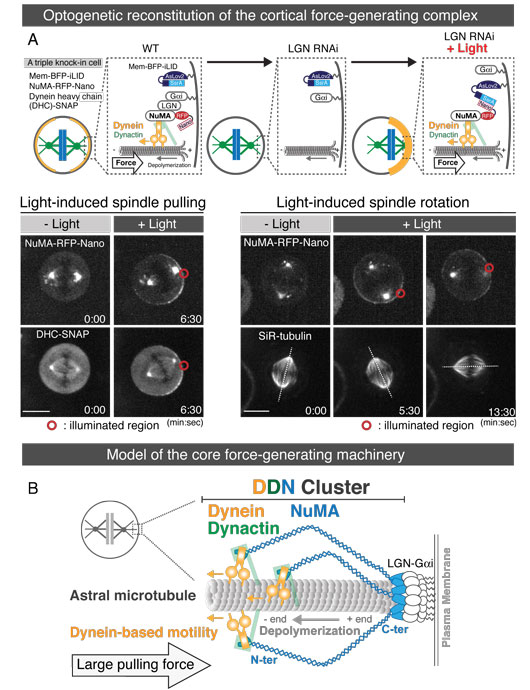In most animal cells, the cortical force-generating machinery consists of the evolutionally conserved cytoplasmic dynein motor, its binding partner dynactin, and the cortically-anchored NuMA-LGN-Gαi complexes (see Figure A, left). However, in contrast to other force-generating complexes such as the chromosome-bound kinetochore structure, how this diffusion-prone, membrane-anchored complex efficiently generates cortical spindle-pulling forces on astral microtubule tips remains poorly understood.
In this study, we have developed a light-induced reconstitution system in human cells and asked whether light-induced cortical targeting of specific factors is sufficient for force generation to position or orient the spindle (see Figure A).

Figure: A. (Top) Diagram summarizing the strategy for light-induced reconstitution of the cortical force-generating complexes. (Bottom) Light-induced spindle pulling (left) and rotation (right). B. Model showing multiple-arm capture and pulling of an astral microtubule by the cortical DDN cluster.
Our work defines the core functional modules and architecture of the cortical force-generating machinery in human cells and changes the paradigm for cortical pulling-force generation: the cortical dynein motor itself is NOT sufficient, but cortical Dynein-Dynactin-NuMA (DDN) clusters generate functional spindle-pulling forces as a multi-arm ensemble (see Figure B).
Our work has broad implications for understanding the mechanisms of spindle positioning in both symmetric and asymmetric cell division. Understanding the precise architecture of the interaction between astral microtubule tips and the cortical DDN cluster would be critical in future research. In addition, our optogenetic reconstitution has huge potential to manipulate cell polarity and division symmetry/asymmetry in vivo, which will advance our knowledge and open new directions in diverse cell and developmental biology fields.
Reference
Dynein-Dynactin-NuMA clusters generate cortical spindle-pulling forces as a multi-arm ensemble. Okumura M, Natsume T, Kanemaki MT, Kiyomitsu T. eLife 2018;7:e36559 doi: 10.7554/eLife.36559


































